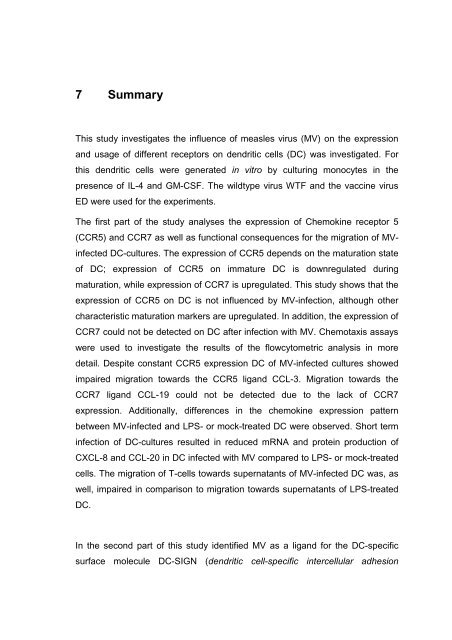Interaktion von Masernviren mit Dendritischen Zellen - OPUS ...
Interaktion von Masernviren mit Dendritischen Zellen - OPUS ...
Interaktion von Masernviren mit Dendritischen Zellen - OPUS ...
Erfolgreiche ePaper selbst erstellen
Machen Sie aus Ihren PDF Publikationen ein blätterbares Flipbook mit unserer einzigartigen Google optimierten e-Paper Software.
7 Summary<br />
This study investigates the influence of measles virus (MV) on the expression<br />
and usage of different receptors on dendritic cells (DC) was investigated. For<br />
this dendritic cells were generated in vitro by culturing monocytes in the<br />
presence of IL-4 and GM-CSF. The wildtype virus WTF and the vaccine virus<br />
ED were used for the experiments.<br />
The first part of the study analyses the expression of Chemokine receptor 5<br />
(CCR5) and CCR7 as well as functional consequences for the migration of MV-<br />
infected DC-cultures. The expression of CCR5 depends on the maturation state<br />
of DC; expression of CCR5 on immature DC is downregulated during<br />
maturation, while expression of CCR7 is upregulated. This study shows that the<br />
expression of CCR5 on DC is not influenced by MV-infection, although other<br />
characteristic maturation markers are upregulated. In addition, the expression of<br />
CCR7 could not be detected on DC after infection with MV. Chemotaxis assays<br />
were used to investigate the results of the flowcytometric analysis in more<br />
detail. Despite constant CCR5 expression DC of MV-infected cultures showed<br />
impaired migration towards the CCR5 ligand CCL-3. Migration towards the<br />
CCR7 ligand CCL-19 could not be detected due to the lack of CCR7<br />
expression. Additionally, differences in the chemokine expression pattern<br />
between MV-infected and LPS- or mock-treated DC were observed. Short term<br />
infection of DC-cultures resulted in reduced mRNA and protein production of<br />
CXCL-8 and CCL-20 in DC infected with MV compared to LPS- or mock-treated<br />
cells. The migration of T-cells towards supernatants of MV-infected DC was, as<br />
well, impaired in comparison to migration towards supernatants of LPS-treated<br />
DC.<br />
In the second part of this study identified MV as a ligand for the DC-specific<br />
surface molecule DC-SIGN (dendritic cell-specific intercellular adhesion

















